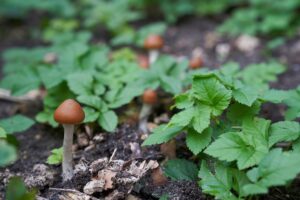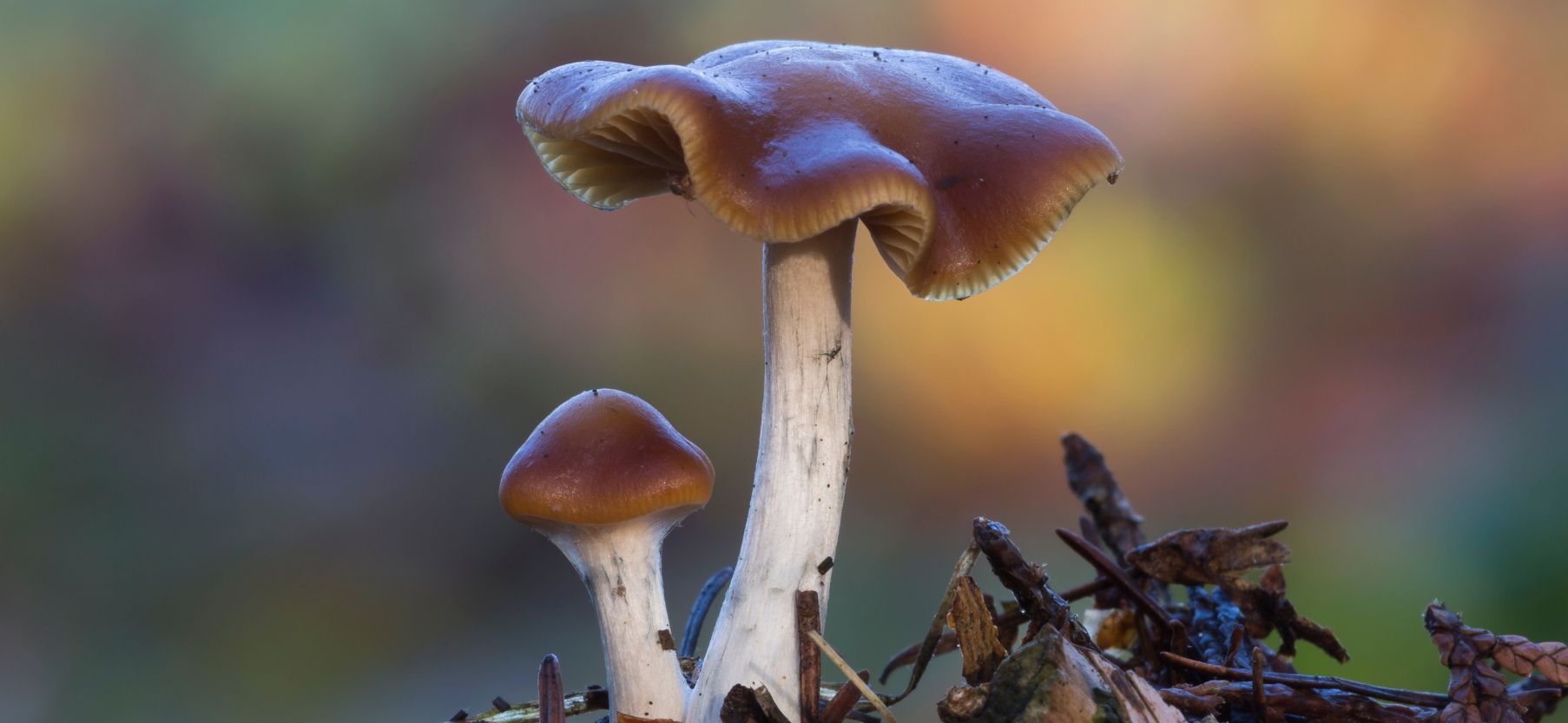UPDATED: September 7, 2022
It isn’t that the wavy cap mushroom is lazy, it’s just that this fungi, also known by its scientific name Psilocybe cyanescens, knows the path of least resistance when it sees it. Back in 2011, British researcher Geoffrey Kibb stumbled across an entire field of wavy caps — tens of thousands of them growing wild at a racetrack in southern England. And while this varietal of psychedelic mushroom isn’t native to the UK, it was certainly thriving there.
The explanation? Weed-averse gardeners and the wood chips they use to keep the dandelions away from their daffodils.
Wavy caps, which are thought to have originated in Central Europe but whose natural home on the American continent is in the Pacific Northwest (from British Columbia to California), typically sprout up on decaying trees felled in the forest. But forcing delicate mushroomy roots through dense, fibrous logs is hard work for little fungi. Wood chips provide a far more leisurely growing platform — and a mobile one, too, as gardening supplies are shipped in bulk internationally with P. cyanescens spores in tow.

First documented in the western world in 1946 by mycologist Elsie Wakefield, Psilocybe cyanescens have a farinaceous or flour-like smell and taste but become bitter when boiled. This doesn’t do much for their popularity in the culinary world, despite the fact that boiling the mushrooms relieves them of their psychoactive properties.
P. cyanescens contain 30 to 60 percent more psilocybin than P. cubensis
Out of more than 200 species of psychoactive fungi in existence, the wavy cap is among the most potent of psychedelic mushrooms in terms of its hallucinogenic powers. The mushroom’s psilocybin content falls between 0.39 and 0.66 percent with 0.75 to 1.96 percent psilocin levels. That means that Psilocybe cyanescens contain, on average, 30 to 60 percent more psilocybin than Psilocybe cubensis (though they contain slightly less psilocin). When metabolized, the psilocybin can act as a serotonin imitator, producing a euphoric high, introspective thought, occasional synesthesia and visual or auditory effects. Due to their higher psilocybin content, wavy caps are noted for producing intense visuals.
Because of their inclination to travel, wavy capped mushrooms can be found growing in the wild as well as in urban gardens, popping up amid the mulch used in plant beds. Identified by their relatively large (up to 6cm) cap that first appears as an orangey-brown, deepening in color to an ochre-brown as the fungi dry out, wavy caps live up to their name with ripples appearing around the edges of the cap of the growing mushroom. They’re a gilled mushroom, making them a member of the Hymenogastraceae family of fungi. What makes Psilocybe cyanescens (as well as several other types of psychedelic mushrooms) stand out is their propensity to bruise blue and purple when handled along the stem and at the edges of the cap.
Why Psilocybe cyanescens bruises blue
The blue-bruising phenomenon has intrigued scientists ever since the mushroom‘s discovery. Working with the knowledge that the hue was caused by oxidized psilocybin, German researcher Claudius Lenz from the Leibniz Institute for Natural Product Research and Infection Biology delved into the whats and whys behind the mushroom mystery. His study revealed that the blue compounds found in certain mushrooms and indigo “share structural similarities in the indole core, and in both the basis for the colour is a quinoid.” Translation: the magic mushroom blue is similar to the indigo pigment used to dye denim and it’s derived from a complex oxidation mixing process rather than a single compound.

The blue bruisability is one factor that can distinguish the wavy cap from its poisonous look-alike cousin, the Galerina mushroom — which often grows right alongside it. “They are easily confused with other small brown mushrooms, many of which are poisonous to various degrees,” says Brian Starzomski, director of the School of Environment at the University of Victoria. The Galerina, for example, can be deadly if consumed. The best and safest way to tell the species apart is by their spore colour. Wavy caps have dark purplish-gray to very dark reddish-brown spores. Differentiating them is not a job for hobbyists and amateurs. “Always ask for help if you’re not 100 percent sure,” says Starzomski.
Even the blue factor isn’t a guarantee of safety or psychedelic properties — the German research team are still investigating why blueing occurs in multiple mushroom species. “Our hypothesis — and we don’t have any evidence for this yet — is that it might serve a protective role, like an on-demand repellent against predators,” says the Leibniz Institute’s Dirk Hoffmeister.
What they are certain of is that magic mushrooms like the P. cyanescens should be the next big thing in mental health therapy. “Psilocybin is looked at as this illegal, recreational drug,” says Hoffmeister, “but it has a fantastic potential as a medication for therapy resistant depression.”
In fact, psilocybin is being studied for its potential to treat a multitude of conditions. In the summer of 2022, Johns Hopkins’ Center for Psychedelic and Consciousness Research revealed that they would be conducting a trial using psilocybin to alleviate symptoms of Post-treatment Lyme Disease (PTLDS). Lyme Disease is a tick-borne illness, typically treated with a course of antibiotics but some patients continue to experience symptoms of fatigue, body pain, and brain fog for months even after receiving treatment. Beyond antibiotics, additional treatment does not exist for those suffering from PTLDS, thought to be an autoimmune response triggered by the initial infection. (Recently, country singer Shania Twain revealed that PTLDS nearly ended her singing career, causing her to black out repeatedly while performing.) The CPCR’s Dr. Albert Garcia-Romeu will test whether or not psilocybin can be used safely to relieve fatigue, pain, and improve mood in people suffering from PTLDS.

